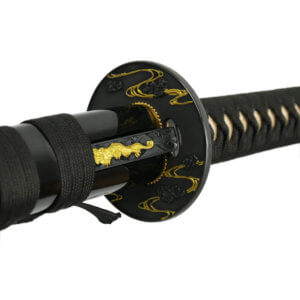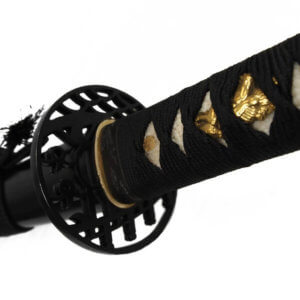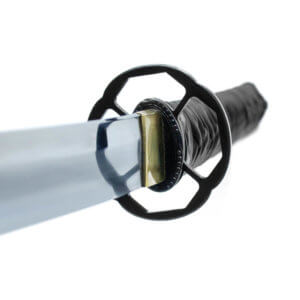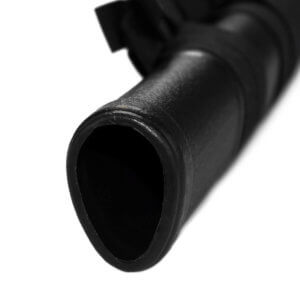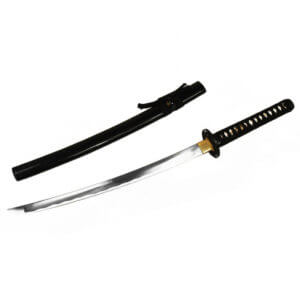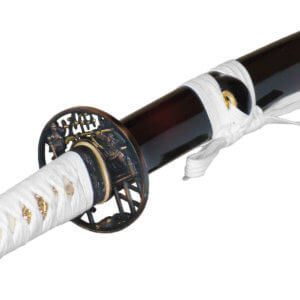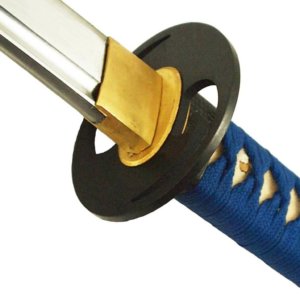Japanese sword types Introduction
Samurai swords, usually called katana (刀 in Japanese), are commonly referred to as all Japanese curved long swords with a single-edged blade. In this article, we would like to outline different types of Japanese swords and roughly classify and differentiate between them in terms of their historical development.
The length of the blade provides a clue to the correct name of the respective Japanese sword type, although there is an overlap between "short long swords" and "long short swords", which can have the same length.
Ultimately, the mount (Koshirae) is decisive for the designation.
Before we mention the corresponding names, the important basic information is that the expressions Katana/Gatana/To/Chi all correspond to the Japanese character 刀. Most names from the world of Japanese swords are made up of a suffix and this character, e.g. 太刀= Tachi= Ta Chi, which means big sword.
Jokoto (古代刀)
Jokoto is an umbrella term for all types of Japanese swords from ancient times. These were the most common swords before curved and single-edged swords such as tachi and katana came into fashion.
Such swords already existed in the Stone Age, with most examples dating back to the Bronze Age. The first bronze objects found in Japan date back to the 3rd century BC.
Jokoto are usually straight swords that are mainly intended for stabbing.
Typical examples of jokoto are the sword types chokuto and tsurugi.
It was long believed that the swords were imported exclusively from Korea and China. However, during excavations in Japan in the late 20th century, moulds for such swords were also found, which suggests that the Japanese were already making some types of Japanese swords themselves in ancient times.
Chokuto (直刀)
The chokuto is a straight sword that has been found in tombs from the fourth and fifth centuries in Japan. For example, in the famous tomb of Tenno Nintoku from the 5th century. These very early models were mostly imports from Chinawhich found their way to Japan. They already have a single-edged blade and can therefore be regarded as the direct predecessor of the later samurai swords. Unfortunately, it is not known exactly when the production of this type of sword began in Japan. The first swords were a pure copy of Chinese swords from the same period. Over time, however, they developed into the later samurai swords in Japan.
Tsurugi (剣)
It probably originated in China and was used in Japan from the middle of the seventh century. This sword had a straight, double-edged blade. It therefore does not correspond to the shape of the later samurai swords and was not used in Japan for as long as in China. With the development of curved blades, this type of sword lost its importance in Japan.
Tachi (太刀)
According to legend, the blacksmith Amakuni forged the first sword of this type as early as the 8th century. During political changes in ancient Japan, the new class of samurai emerged at the beginning of the 10th century, who maintained their claim to power through warlike behaviour. The samurai chose single-edged swords with a curved blade as their main weapon. From then on, the legendary samurai swords continued to evolve. Samurai swords are divided into different sword eras: Koto Katana, Shinto Katana, Shin-Shinto Katana and Gendaito Katana. We may go into this point in more detail elsewhere. However, it is too extensive to deal with here.
Most early samurai sword blades had a blade length of 120 cm or more and were tachi. Tachi refers to long, massive, curved Japanese swords. Tachi translates as "large sword". It was mainly used by horsemen and was designed in size and shape for fighting from horseback. It is characterised by the relatively large curvature of the blade and the curved handle. It is worn on the belt with the cutting edge pointing downwards.
At the imperial court of Japan, the tachi was part of the prescribed ceremonial dress. It is considered the most noble design among the Japanese sword types.
Uchigatana (打刀)
The uchigatana became established in the 14th century. The uchigatana is smaller than the tachi. It is therefore suitable for fighting in small spaces (e.g. in buildings). It was carried on the belt with the blade pointing upwards and could therefore be drawn much faster. In contrast to the tachi, the handle of the uchigatana is straight. Today, the term uchigatana is often used synonymously with the name katana.
Katana (刀)
Over time, the blades of the original tachi became shorter and shorter for better handling. Another development was that the swords were worn on the belt with the cutting edge pointing upwards. These are the characteristics of the katana. Katana became common in the 14th century and especially in the peacetime period from the 17th century onwards. It is worn on the belt and tends to have a straight grip. Roughly speaking, the length is approx. 100 cm.
The word katana is a general term for Japanese swords, as written in the introduction. Nevertheless, outside Japan it is mainly used for this one type of samurai sword.
While the previous Tachi sword was designed for riders, the Katana is optimised for fighting on the ground.
It is the legendary primary weapon of the samurai. Today it is the most recognised type of sword among samurai swords.
Wakizashi (脇差)
Wakizashi is the name given to the slightly shorter samurai sword. It was created around the same time as the katana. It is a secondary weapon and is wielded with one hand, making it the direct descendant of the uchigatana.
The length is roughly approx. 70 cm. The cutting edge points upwards when worn on the belt.
This sword was particularly popular during the period of peace from the early 17th century and was carried by the samurai together with the katana. Other social classes carried other types of Japanese swords, such as the wakizashi as a single sword.
Modern produced Katana & Wakizashi in our online shop
Daisho (大小)
Daisho (literally "big/small") is used in the Japanese language for similar pairs of a small and a large object. In the context of Japanese sword types, it refers to a pair of swords consisting of a long and a short sword.
It was considered a status symbol of the samurai, as only they were allowed to carry this pair of swords in public. A daisho consists of a daito and a shoto:
Daito (大刀)
The daito (="long sword") is therefore the longer sword of the sword pair. The katana often forms the longer sword of the daisho. The longer sword was usually the fighter's primary weapon.
Shoto (小刀)
The shoto (="small sword") is therefore the shorter sword of the pair, which was used as a "secondary weapon". A wakizashi was often used as a shoto.
Tanto (短刀)
Means short sword and can be regarded as a knife or dagger. It has a length of approx. 30 cm. Samurai often carried it as an additional weapon to their normal swords.
The tanto was already carried with the tachi as a second weapon and is therefore one of the oldest types of Japanese swords.
It was also worn by many civilians.
The end of social significance
It was one of the privileges of the samurai to be allowed to carry the daisho in public. During the long period of peace from the early 17th century onwards, samurai swords and their design became a status symbol. The swords were used to show who you were to the outside world. As a result, the martial use took a back seat and the artistic aspect took centre stage.
In the course of the Meiji Restoration in the 19th century, the samurai lost their special privileges and were no longer allowed to carry swords in public.
For this reason, swords were now kept at home and were no longer the public symbol of an entire social class.
This meant that the former public significance of all Japanese sword types was lost.
Gun-to (軍刀)/ Kyu-gunto(旧軍刀)/ Shin-gunto (新軍刀)
Gunto is an umbrella term for all types of Japanese military swords.
During the industrialisation of Japan in the 19th century, the original sword style fell by the wayside. After being trained by Western military advisors, the imperial forces used swords with a predominantly Western design: relatively straight swords with a sabre-like design. In Japanese, these weapons are known as kyu-gunto or "old army swords".
During the 1930s, nationalism spread across Japan. This was fuelled by the fascist government of Japan, which decided to replace the kyu-gunto with a modernised version of the samurai sword to give its forces historical/cultural dignity.
This new weapon is the Shin-Gunto or the "new army sword". It was intended for use by officers in the Imperial Japanese Army and Navy.
The end of military significance
From the middle of the 16th century, firearms were widespread in Japan, so swords gradually lost their military significance.
However, even during the Second World War, the Japanese military still sometimes carried swords as an accessory weapon, more for symbolic reasons.
After Japan's defeat in the Second World War, Japan was occupied by the USA. The American military had set itself the goal of seizing all weapons in the country as a symbolic act.
In the course of this, all swords of the Japanese military were also withdrawn, thus ending the military significance of the samurai sword.
Many swords from Japan were brought to the USA or destroyed during the operation. Fortunately, the original plan was not completely carried out, but many culturally valuable artefacts were lost, such as the Honjo Masamuneto which we have dedicated a separate article.
However, some specimens have also survived, such as the legendary Tenka Goken.
Development since the post-war period
During the occupation of Japan, it was forbidden to produce swords. As a result, the line was interrupted and the knowledge of how to make blades could not be passed on seamlessly. After the end of the occupation, the production of swords started again, but was very strictly regulated.
In Japan, only specially licensed swordsmiths are allowed to produce swords using the traditional method and the quantity that a blacksmith is allowed to produce is limited.
This strict regulation leads to the high quality and high prices of swords from Japan. However, the regulation also severely restricts the opportunities and prospects for innovation.
The first companies specialising in the production of samurai swords outside Japan began to appear in the 1990s.
Outside Japan, blades can be produced without strict regulation and thus exclusively according to the needs of the market.
That is why there are different development streams today:
On the one hand, there is the strictly regulated market in Japan, which produces very high-quality swords and is therefore of particular interest to collectors and well-heeled enthusiasts.
The second is the free market outside Japan, which produces swords using customised production methods. This market offers the opportunity to obtain swords at prices that would not be possible in Japan. However, due to the low level of regulation, there are also many poor quality products on the market. In addition, the market is littered with misinformation, for example about Folding and Structure of sword blades. It is therefore important to buy from a dealer with (genuine) expertise. Even brands that have built up a good reputation through marketing are often not the real deal. Cheap samurai swords with a good price-performance ratio from us at Shop buy.
Other frequently used names
In the previous text, we roughly described the history of the Japanese sword. Of course, there are many other names for Japanese sword types.
One more frequently used term:
Bokken (木剣) and bokuto (木刀)
A training sword made of wood. The name is made up of the word boku (wood) and ken or to for sword. The term bokuto is widely used in Japan, while the term bokken has become established outside Japan.
Iaido (居合道)
Iaido is the "art of sword drawing". A martial arts discipline that deals with the countless ways to draw a Japanese sword.
Iaito (居合刀)
A training sword with a blunt metal blade, which is why it is only intended for practising. The blades are often made from a mixture of aluminium as opposed to swords made from the usual types of steel. It is relatively light to take the strain off the joints during training, which is particularly important for beginners. The term is often confused with the similar term Iaido.
Kendo (剣道)
Means "the way of the sword". A martial art in which, according to modern interpretation, fighting with a sword is trained.
Kenjutsu (剣術)
"The art of the sword". A martial arts discipline that teaches the use of a sword according to traditional standards.
Nihonto (日本刀)
It is made up of the terms Nihon=Japan and To=sword. In other words, an umbrella term for all swords from Japan. About Nihonto we have our own contribution, which here is to be found.
Nodachi (野太刀)
Nodachi means field tachi, i.e. large field sword.
Odachi (大太刀)
Means big tachi, which translates to big sword. Basically a larger tachi, although there is no precise definition of when a normal tachi counts as an odachi.
Kodachi (小太刀)
It is made up of the terms ko (=small) and tachi. It is therefore a small tachi with a length of approx. 70 cm. This makes it roughly the size of a wakizashi. The kodachi is worn on the belt like a tachi with the blade pointing downwards.
Shinken (新刀)
A real sword with a sharp blade. It is the counterpart to the Iaito. The Iaito has a blunt blade made of light metal, whereas the Shinken's blade is made of steel and is sharp. It is also used in some martial arts by advanced practitioners in normal training. Such swords are also suitable for cutting exercises.
In this video we show some types of Japanese swords:
In addition to the history of the sword, there have also been countless outstanding samurai and leaders in Japanese history. You can find our top 10 of the most outstanding personalities in this Contribution.


